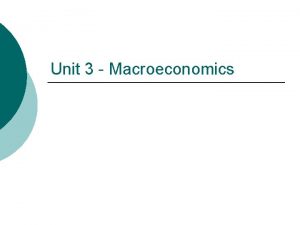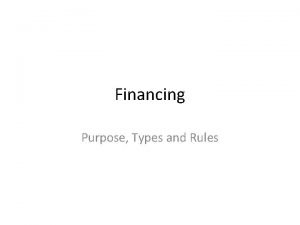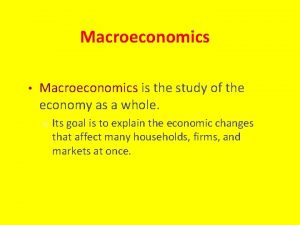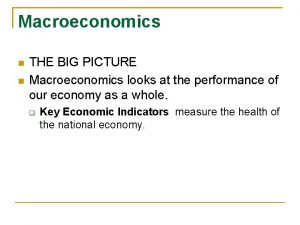MACROECONOMICS What is the purpose of macroeconomics to


















- Slides: 18

MACROECONOMICS What is the purpose of macroeconomics? • to explain how the economy as a whole “works” • to understand why macro variables behave in the way they do (trends and fluctuations) • to predict the consequences of policy action

COURSE OUTLINE 1. The macro-economy: a theoretical model 2. Controlling the economy: fiscal policy 3. Controlling the economy: monetary policy 4. Policy issues: inflation and unemployment 5. International macroeconomics

Macroeconomic variables • national income and output • employment and unemployment • wages, price level and inflation • interest rates and money supply • consumption, saving and investment • exports and imports • government spending and taxation • foreign exchange markets and exchange rates

What factors determine national income and employment? Can the government affect national income through fiscal and monetary policy? How do interest rate decisions reached by the central bank affect the economy? What factors determine national savings and investment? What factors determine the exchange rate? Why is the trade balance important?

THE CIRCULAR FLOW OF INCOME Exports Imports Investment Demand for goods Households Government Firms Tax Wages, profits

A MACROECONOMIC MODEL: THE DEMAND SIDE Building blocks • consumption • investment • government spending • exports • imports 65% 15% 20% 25% -25% These five variables play a critical role in determining national income and employment. Hence: need to be explained.

What determines aggregate consumption? • disposable income (Y - T) • interest rates (investment) • uncertainty (confidence in future income stream) • wealth (asset prices, house prices) • expected future income (e. g. pensions) • age structure of population

Investment • new capital equipment; not savings/ shares What determines investment? • initial cost of investment • interest rate (cost of borrowing) • expected future income from investment The investment decision PV of investment - cost of investment > 0

Sources and cost of funds: • internal funds (retained profits) • borrowing from financial institutions • selling equity stock in business How would a reduction in interest rates affect investment? • lower borrowing costs • lower mortgage rates (higher demand for houses) • lower borrowing costs: higher demand for goods

Exports and imports are determined by: - exchange rate: $ /£ - competitiveness: relative prices - world income - price and income elasticities

DETERMINATION OF NATIONAL INCOME: A DEMAND-BASED MODEL 1. Aggregate supply of goods responds to demand i. e. unlimited supplies of labour and capital 2. Aggregate demand for goods is determined as follows: AD = C + I + G + X - M 3. Predictions: - if AS > AD, stocks increase, output falls - if AD > AS, stocks decrease, output rises - if AD = AS, economy is in equilibrium

Factors causing national income to change 1. If expenditure (AD) increases, so will income (GDP) 2. Why might expenditure increase? • Increase in consumption due to: - increase in expected future income - increase in wealth (house prices, stock market) - fall in interest rates (monetary authorities) - lower taxes (govt. policy) - fall in prices • Increase in investment due to: - increase in expected profits (business optimism) - fall in borrowing costs

• Increase in government spending: - increase in transfer payments - increase in capital spending - increase in expenditure on education/ health • Increase in net exports: - fall in exchange rate - increase in competitiveness - increase in world income

THE SUPPLY SIDE So far: we have assumed that AD alone determines national income What about supply-side constraints? • capital stock is limited in the short run • supply of labour is limited • skills shortages may arise

Implications of a limited supply of factor inputs • wages increase as labour demand increases • diminishing marginal productivity (fixed supply of capital) • producers willing to supply more output only at higher prices • supply can be increased over the long run (increase in capital stock)

Revised model • interaction between AD and AS determines the economy’s output and price levels Consider the effects of: - an increase in production costs - an increase in the supply of resources (e. g. capital stock, technology) - an increase in the demand for goods

Extended model Assumption: AS is fixed by the economy’s output capacity • labour market is assumed to clear (full employment) • AD negatively related to price level - fall in price leads to higher demand (real money balances increase, spending increases) - fall in price reduces demand for money, interest rates fall (lower interest rate, higher spending) • AD positively related to aggregate spending - investment increases as business expectations improve

• AD positively related to money supply - if money supply increases, interest rate falls (investment increases) A further modification • AS may not be fixed at the full employment level • AS may be upward sloping in the short run: - sticky prices - unemployed labour willing to work at current wages ( costs do not rise as more labour is employed)
 Thế nào là hệ số cao nhất
Thế nào là hệ số cao nhất Diễn thế sinh thái là
Diễn thế sinh thái là đại từ thay thế
đại từ thay thế Ng-html
Ng-html Vẽ hình chiếu vuông góc của vật thể sau
Vẽ hình chiếu vuông góc của vật thể sau Thế nào là mạng điện lắp đặt kiểu nổi
Thế nào là mạng điện lắp đặt kiểu nổi Mật thư tọa độ 5x5
Mật thư tọa độ 5x5 Lời thề hippocrates
Lời thề hippocrates Vẽ hình chiếu đứng bằng cạnh của vật thể
Vẽ hình chiếu đứng bằng cạnh của vật thể Tư thế worm breton là gì
Tư thế worm breton là gì Quá trình desamine hóa có thể tạo ra
Quá trình desamine hóa có thể tạo ra Khi nào hổ con có thể sống độc lập
Khi nào hổ con có thể sống độc lập Các châu lục và đại dương trên thế giới
Các châu lục và đại dương trên thế giới Dot
Dot điện thế nghỉ
điện thế nghỉ Bổ thể
Bổ thể Thế nào là sự mỏi cơ
Thế nào là sự mỏi cơ 101012 bằng
101012 bằng Thiếu nhi thế giới liên hoan
Thiếu nhi thế giới liên hoan



































